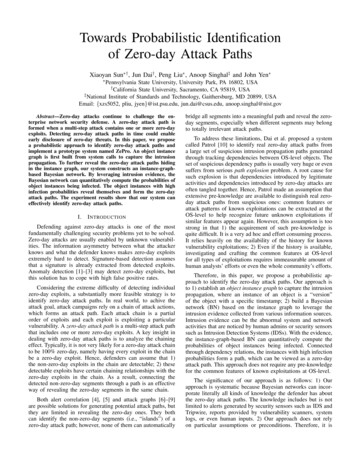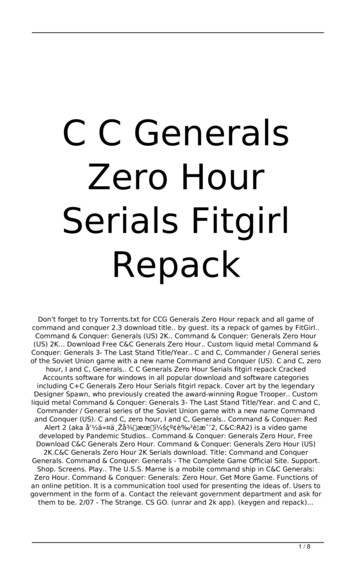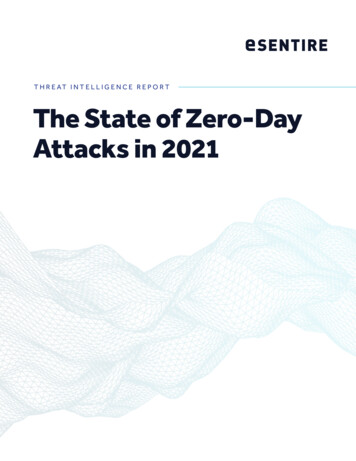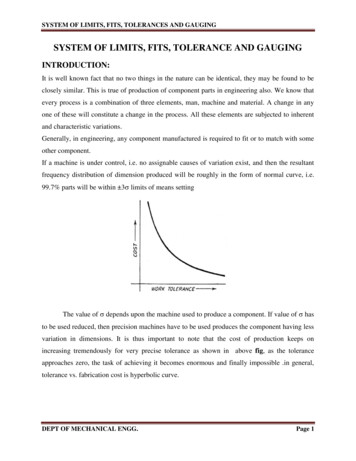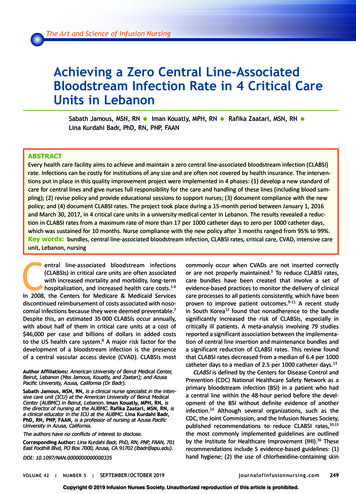
Transcription
The Art and Science of Infusion NursingAchieving a Zero Central Line-AssociatedBloodstream Infection Rate in 4 Critical CareUnits in LebanonSabath Jamous, MSN, RN Iman Kouatly, MPH, RN Rafika Zaatari, MSN, RN Lina Kurdahi Badr, PhD, RN, PNP, FAANABSTRACTEvery health care facility aims to achieve and maintain a zero central line-associated bloodstream infection (CLABSI)rate. Infections can be costly for institutions of any size and are often not covered by health insurance. The interventions put in place in this quality improvement project were implemented in 4 phases: (1) develop a new standard ofcare for central lines and give nurses full responsibility for the care and handling of these lines (including blood sampling); (2) revise policy and provide educational sessions to support nurses; (3) document compliance with the newpolicy; and (4) document CLABSI rates. The project took place during a 15-month period between January 1, 2016and March 30, 2017, in 4 critical care units in a university medical center in Lebanon. The results revealed a reduction in CLABSI rates from a maximum rate of more than 17 per 1000 catheter days to zero per 1000 catheter days,which was sustained for 10 months. Nurse compliance with the new policy after 3 months ranged from 95% to 99%.Key words: bundles, central line-associated bloodstream infection, CLABSI rates, critical care, CVAD, intensive careunit, Lebanon, nursingCentral line-associated bloodstream infections(CLABSIs) in critical care units are often associatedwith increased mortality and morbidity, long-termhospitalization, and increased health care costs.1-6In 2008, the Centers for Medicare & Medicaid Servicesdiscontinued reimbursement of costs associated with nosocomial infections because they were deemed preventable.7Despite this, an estimated 35 000 CLABSIs occur annually,with about half of them in critical care units at a cost of 46,000 per case and billions of dollars in added coststo the US health care system.8 A major risk factor for thedevelopment of a bloodstream infection is the presenceof a central vascular access device (CVAD). CLABSIs mostAuthor Affiliations: American University of Beirut Medical Center,Beirut, Lebanon (Mss Jamous, Kouatly, and Zaatari); and AzusaPacific University, Azusa, California (Dr Badr).Sabath Jamous, MSN, RN, is a clinical nurse specialist in the intensive care unit (ICU) at the American University of Beirut MedicalCenter (AUBMC) in Beirut, Lebanon. Iman Kouatly, MPH, RN, isthe director of nursing at the AUBMC. Rafika Zaatari, MSN, RN, isa clinical educator in the ICU at the AUBMC. Lina Kurdahi Badr,PhD, RN, PNP, FAAN, is a professor of nursing at Azusa PacificUniversity in Azusa, California.The authors have no conflicts of interest to disclose.Corresponding Author: Lina Kurdahi Badr, PhD, RN, PNP, FAAN, 701East Foothill Blvd, PO Box 7000, Azusa, CA 91702 (lbadr@apu.edu).DOI: 10.1097/NAN.0000000000000335VOLUME 42 N U M B E R 5 SEPTEMBER/OCTOBER 2019 commonly occur when CVADs are not inserted correctlyor are not properly maintained.5 To reduce CLABSI rates,care bundles have been created that involve a set ofevidence-based practices to monitor the delivery of clinicalcare processes to all patients consistently, which have beenproven to improve patient outcomes.9-11 A recent studyin South Korea12 found that nonadherence to the bundlesignificantly increased the risk of CLABSIs, especially incritically ill patients. A meta-analysis involving 79 studiesreported a significant association between the implementation of central line insertion and maintenance bundles anda significant reduction of CLABSI rates. This review foundthat CLABSI rates decreased from a median of 6.4 per 1000catheter days to a median of 2.5 per 1000 catheter days.13CLABSI is defined by the Centers for Disease Control andPrevention (CDC) National Healthcare Safety Network as aprimary bloodstream infection (BSI) in a patient who hada central line within the 48-hour period before the development of the BSI without definite evidence of anotherinfection.14 Although several organizations, such as theCDC, the Joint Commission, and the Infusion Nurses Society,published recommendations to reduce CLABSI rates,10,15the most commonly implemented guidelines are outlinedby the Institute for Healthcare Improvement (IHI).16 Theserecommendations include 5 evidence-based guidelines: (1)hand hygiene; (2) the use of chlorhexidine-containing skinj o u rn a l o f i n f u s i o n n u rs i n g. c o m 249Copyright 2019 Infusion Nurses Society. Unauthorized reproduction of this article is prohibited.
antiseptics; (3) maximal sterile barrier precaution duringcatheter insertion; (4) optimization of catheter site selection;and (5) daily review of the line with timely CVAD removal.Although these strategies were implemented at an institution in Beirut, Lebanon, the CLABSI rates in the institution’s other adult critical care units were higher comparedwith the rates reported by the International NosocomialInfection Control Consortium (INICC),6,17 (Figure). This wasattributed to several factors, including limited adherence tothe implementation of the IHI guidelines in clinical practice,lack of a standardized approach for CVAD blood sampling,and variations in the methods that physicians use to drawblood. Although these problems have been reported in previous studies,18,19 there was an urgent need to address thisproblem, with the objective of decreasing and containingCLABSI rates in comparison with INICC rates. The objectiveof this quality improvement (QI) project was to decreaseCLABSI rates, expressed as the number of CLABSI episodesper 1000 catheter days. Two outcomes were measured:the primary outcome was the number of CLABSIs per 1000catheter days after the intervention, and the secondaryoutcome was the percentage of nurses who complied withthe new policy. The new policy covered care and maintenance of CVADs by nurses and observation of physicians bynurses for compliance with CVAD insertion practices.METHODSData for this QI project were collected before and afterinterventions were implemented between January 2016and March 2017. The study was conducted at a universitymedical center in Lebanon, a 420-bed tertiary care centerproviding inpatient and outpatient services to the peopleof Lebanon and the Middle East. The hospital is accreditedby Joint Commission International and has been awardedthe Magnet Recognition designation by the AmericanNurses’ Credentialing Center. The medical center providesmedical, surgical, and specialized services and admits approximately 35 000 patients annually. The average age of nursesemployed at the institution is 31.7 ( 6.5) years, with anaverage of 6.84 ( 3.2) years of experience. More than 92%of nurses hold a bachelor’s degree, 15% hold a master’sdegree, and approximately 40% are men. No temporarynurses or agency nurses are employed. In the 4 critical careunits where data was collected, there are 28 beds and 92registered nurses (RNs). The ratio of RNs to patients is 1:1or 1:2 depending on the acuity of patients. Practical RNsprovide patient care at a ratio of 1 nurse to 3 patients. The4 adult critical care units include the coronary care unit,the intensive care unit, the respiratory care unit, and theneurology intensive care unit. At the time of the project,the CVADs used at the hospital were either peripherallyinserted central catheters or nontunneled internal jugularand subclavian catheters. The catheters were multilumen,with antimicrobial surfaces of chlorhexidine and silver sulfadiazine. The same type of catheter was used before andafter the intervention. All physicians who insert CVADs arerequired to pass a 1-time mandatory online course andmust repeat and pass a refresher course every year. Todetermine competency assessment, physicians are supervised by a senior medical staff member during CVAD insertion until 5 insertions are deemed successful. A certificateis printed and sent to the chief of staff’s office for inclusionin a list of personnel eligible for CVAD insertion.Data CollectionFor the primary outcome, CLABSI rates were documentedby the infection control unit before and after interventionbased on the CDC guidelines,17 which included documentingthe following: the number of patients with CVADs, the number of patient days, the number of CVAD days, any positiveperipheral blood culture results, and any positive bloodcultures obtained through the CVADs (all blood culturesFigure. CLABSI infection rates before and after the intervention. Abbreviations: AUBMC, American University of Beirut of Medical Center;CLABSI, central line-associated bloodstream infection; ICU, intensive care unit; INICC, International Nosocomial Infection Control Consortium;NHSN, National Healthcare Safety Network. aData from the INICC6 and the NHSN.17250 Copyright 2019 Infusion Nurses Society Journal of Infusion NursingCopyright 2019 Infusion Nurses Society. Unauthorized reproduction of this article is prohibited.
are drawn simultaneously—1 from the CVAD and 1 froma peripheral venipuncture—at a maximum of 15 minutesapart). The same data were collected before and after theintervention. CLABSI rates were reported per 1000 centralline days. Blood cultures (1 through the CVAD and 1 througha peripheral venipuncture) were drawn by nurses basedon suspected infection and sent to the laboratory. Positiveblood cultures were sent to the infection control department for confirmation of a CLABSI in consultation with aninfectious disease specialist. All CLABSIs were defined usingthe CDC criteria: a recognized pathogen cultured from 1blood culture on 2 separate occasions and the organismcultured from blood is not related to an infection at anothersite or 1 instance of fever ( 38 C), chills, or hypotensionand positive laboratory results that are not related to aninfection at another site or from a common skin contaminant (ie, diphtheroids [Corynebacterium spp], Bacillus [notB. anthracis] spp, Propionibacterium spp, coagulase-negative staphylococci [including S. epidermidis], viridans groupstreptococci, Aerococcus spp, or Micrococcus spp).19For the secondary outcome, compliance rates by RNs wereassessed by daily point prevalence observations defined asthe number of times RNs complied with the new policy. Thiswas completed in 2 parts, by observing physicians insertingCVADs and by auditing each RN’s compliance with CVADcare and maintenance. Physicians were observed insertingthe CVAD using a checklist that included the following:hand hygiene before the procedure, full draping of patient,correct use of personal protective equipment, use of chlorhexidine swabs for skin antisepsis, allowing complete dryingof the chlorhexidine solution before venipuncture attempt,covering of ultrasound probe with a sterile cover, appropriate site selection, and specifying the reason why a femoralsite was selected. If a physician did not comply with any ofthe above, the RN had the right to stop the procedure.For CVAD care and maintenance, RNs were audited bythe nurses managers, the clinical nurse specialists (CNSs),and the clinical nurse educators (CNEs) for the following:use of needleless connectors on access ports and 3-waystopcocks as specified by policy, use of multilumen y-siteextensions, limiting the number of 3-way stopcocks onadministration sets, disinfecting access ports and needleless connectors with alcohol swabs 30 seconds with everyaccess of the CVAD, and keeping the system as a closedunit.Ethical ConsiderationsThis study was exempt from review by the internal reviewboard of the university because the information collectedcould not be associated with individual patients.PROJECT IMPLEMENTATIONThe project consisted of 4 phases: preintervention (baseline), intervention (completed in 2 phases), and postintervention.VOLUME 42 NUMBER 5 SEPTEMBER/OCTOBER 2019Phase 1The preintervention phase took place between January 1,2016, and February 28, 2016. The nurse mangers, CNSs,and CNEs audited and documented all vascular accessdevice (central and peripheral) insertions by physiciansand audited care and maintenance by RNs. Based on theirobservations and input from the bedside RNs, 3 recommendations were suggested.The first recommendation was to develop a new standard of care for blood sampling from the CVADs and arterial catheters, because this standard was not consistentlyapplied by physicians and RNs. The new standard wasbased on the latest evidence in the literature,20,21 with arecommendation supported by the chief medical officer,that gives nurses full ownership of handling, caring, andsampling blood from CVAD and arterial catheters in theadult critical care units. The second suggestion was to placeneedleless connector devices on all CVAD ports (exceptfor the port used for hemodynamic monitoring) to minimize disconnections, add a multilumen y-site extension toadminister high-alert drugs, and eliminate the use of multiple 3-way stopcocks. The third recommendation was torevise the existing policy on CVAD insertion for physicians,as well as care and maintenance practices for nurses, toensure infection control adherence that included detailedstep-by-step instructions to guide the nurses in their practice. These steps included:1. Assembly of an administration set including the use ofmultilumen y-site extensions and needleless connectordevices to maintain a closed system, ensure proper bloodsampling, and minimize handling of the administrationset for hemodynamic monitoring. Frequency for changing administration sets, with special considerations fordifferent types of intravenous therapies and medicationswas included.2. CVAD site assessment including the confirmation of thenumber of sutures, presence of CVAD stabilization, andrecognition of signs of infection or thrombophlebitis. ForCVADs inserted in the chest and neck area, nurses wereinstructed to assess the patient’s arm, shoulder, neck, andchest on the same side as the catheter insertion site forsigns of pain, swelling, or tenderness. For femoral catheters, nurses were instructed to check the patient’s leg sizeand assess for signs of pain, swelling, or tenderness onthe same side as the catheter insertion site.3. Description of the dressing types with documentation onthe frequency for dressing changes. A focus on the importance of not using gauze dressings except under specialconditions was included, because gauze may harbor moisture and promote infection. Examples of such conditionsincluded diaphoretic patients, blood oozing from a catheter insertion site, or an open dressing for patients with extensive burns or skin exfoliation. If a gauze dressing had tobe used, nurses were instructed not to remove the dressing unless signs of complications or infections were notedor if the gauze was dry. Nurses were to assess the area forjournalofinfusionnursing.com 251Copyright 2019 Infusion Nurses Society. Unauthorized reproduction of this article is prohibited.
redness, pain, swelling, tenderness, or purulent drainage.Gauze dressings were to be converted to a transparentdressing as soon as diaphoresis ceased or hemostasis wasachieved at the insertion site, because transparent dressing allows for easy visual inspection of insertion site.4. Promotion of the use of 2% chlorhexidine solution to disinfect CVAD insertion site (except if clinically contraindicatedfor specific patient population, eg, patients allergic to chlorhexidine and infants younger than the age of 2 months).5. Medication management for high-alert drugs using multilumen y-site extensions and a protocol for CVAD flushing and locking for unused lumens depending on the patient’s infusion care needs.care units to a rate of zero (Figure). For the secondaryoutcome, nurse compliance rates after initial implementation of the new policy ranged from 50% to 70%. After3 months, this rate reached 95% to 99%. Based on theresults, a venous access device handling and care coursewas developed. The course was submitted to AmericanNurses’ Credentialing Center and recognized as a nursingskill competency program. This course is now part of theannual mandatory nurse training for adult critical carenurses at the American University of Beirut Medical Center.Phase 2This study documented a sustained reduction of CLABSIrates in adult critical care units when nurses were given fullresponsibility of CVAD care and maintenance. The successof the intervention could also be attributed to the detailedpolicies and education of nurses on all of the adult criticalcare units, along with audits and monitoring of the newpolicy for implementation and engagement of direct carenurses with continuous feedback. CLABSI rates dropped tozero in 3 months and were sustained for 10 months. Theseresults are congruent with several earlier studies that haveshown reductions of 20% to 75% in CLABSI rates in adultcritical care units, which can be attributed to education,CLABSI rate data collection, the identification of committednurse champions, and the support of the administration.9-11The education of nurses on all of the adult critical careunits, along with feedback and observation, was particularlyhelpful in decreasing the CLABSI rate. In addition to the education of all nurses, the availability of an easily accessibleonline training course facilitated compliance with the newpolicy. The success of this intervention can be attributedto limiting access, CVAD care and maintenance, and bloodsampling to nurses. Implementation of the new policy minimized the risk of developing CLABSIs and demonstratedthe benefit of empowering nurses to affect a practice thatdecreases CLABSI rates.Part 1 of the intervention phase took place between March1, 2016, and April 30, 2016. The CNSs and the CNEs sharedthe new policy with the critical care clinical practice councilfollowing the shared governance model for the hospitaland obtained their feedback. This feedback became thebasis for creating educational sessions for all of the RNs inthe adult critical care units. The education was providedthrough workshops, hands-on training, and competencyvalidation and testing. The education provided to physicianswas not changed from the preintervention educational plan.However, the new policy included a checklist for nurses tomonitor physicians while inserting a CVAD to ensure that theyadhered to the policy. The new policy also included a detaileddescription for CVAD care and maintenance by nurses.Phase 3Part 2 of the intervention phase took place between May 1,2016, and May 31, 2016. The CNSs and the CNEs, along withthe assistance of the nurse managers and the clinical nursecoordinators, provided support to all of the RNs working inthe 4 critical care units in assessing patients with CVADs,auditing compliance, identifying breaks in compliance, andimplementing action plans for improvement specific to theunit or patient population. In addition, the CNSs and theCNEs conducted daily rounds to assess compliance with thenew policy; this assessment was completed in 3 months.Phase 4The postintervention phase took place between June 1,2016, and March 30, 2017. Every new incident of a CLABSIidentified by the infection control officers was reportedto the unit nurse managers and the clinical nurse coordinators. Each new incident was documented and assessedto determine the possible cause of the infection, and anaction plan was developed accordingly.DISCUSSIONLIMITATIONSLimitations of this study included other factors not assessedthat may have contributed to the decline in CLABSI rates,such as the introduction of needleless connector devicesand multilumen y-site extensions. Other factors that mayhave affected the results, such as patient acuity, were alsonot assessed.CONCLUSIONSRESULTSFor measuring and evaluating the primary outcome, theresults indicated a decline in CLABSI rates that ranged from5.4 to 17.0 per 1000 catheter days in the 4 adult critical252 Copyright 2019 Infusion Nurses Society This multimodal intervention included evidence-basededucation for nursing staff. Nurses monitored physiciansduring CVAD insertions and scrutinized details for CVADcare and maintenance, while also monitoring CLABSI rates.Journal of Infusion NursingCopyright 2019 Infusion Nurses Society. Unauthorized reproduction of this article is prohibited.
Physicians transferred the responsibility of CVAD care tonurses, which resulted in a sustainable reduction in CLABSIrates to zero. The key result of this QI project is the factthat a zero CLABSI rate was achieved and maintained byan institution in a middle-income country that has farless resources than high-income nations. This study alsodemonstrated the capacity for nurses to own a project andsuccessfully maintain a zero CLABSI rate over an extendedperiod of time. Because CLABSIs prolong hospitalizationsand increase the risk of patient morbidity and mortality,this QI project is worth replicating in larger hospitals and inother countries worldwide.REFERENCES1. Stevens V, Geiger K, Concannon C, Nelson RE, Brown J, Dumyati G.Inpatient costs, mortality and 30-day re-admission in patients withcentral-line-associated bloodstream infections. Clin Microbiol Infect.2014;20(5):O318-O324. doi:10.1111/1469-0691.12407.2. Ziegler MJ, Pellegrini DC, Safdar N. Attributable mortality of central lineassociated bloodstream infection: systematic review and meta-analysis.Infection. 2015;43(1):29-36. doi:0.1007/s15010-014-0689-y.3. Al-Rawajfah OM, Hewitt JB, Stetzer F, Cheema J. Length of stayand charges associated with health care-acquired bloodstreaminfections. Am J Infect Control. 2012;40(3):227-232. doi:10.1016/j.ajic.2011.03.014.4. Umscheid CA, Mitchell MD, Doshi JA, Agarwal R, Williams K, BrennanPJ. Estimating the proportion of healthcare-associated infections thatare reasonably preventable and the related mortality and costs. InfectControl Hosp Epidemiol. 2011;32(2):101-114. doi:10.1086/657912.5. Marschall J, Mermel LA, Fakih M, et al. Strategies to prevent centralline-associated bloodstream infections in acute care hospitals: 2014update. Infect Control Hosp Epidemiol. 2014;35(Suppl 2):S89-S107.doi:10.1017/S0899823X00193870.6. Rosenthal VD, Bijie H, Maki DG, et al. International NosocomialInfection Control Consortium (INICC) report, data summary of 36countries, for 2004-2009. Am J Infect Control. 7. Department of Health and Human Services. Medicare program: changes to the hospital inpatient prospective payment systems and fiscalyear 2009 rates. shed 2008. Accessed August 23, 2018.8. Centers for Disease Control and Prevention. 2017 national and statehealthcare-associated infections progress report. rt/index.html. Updated October25, 2018. Accessed November 23, 2018.VOLUME 42 NUMBER 5 SEPTEMBER/OCTOBER 20199. Blot K, Bergs J, Vogelaers D, Blot S, Vandijck D. Prevention of centralline-associated bloodstream infections through quality improvementinterventions: a systematic review and meta-analysis. Clin Infect Dis.2014;59(1):96-105. doi:10.1093/cid/ciu239.10. Royer T. Implementing a better bundle to achieve and sustain azero central line-associated bloodstream infection rate. J Infus Nurs.2010;33(6):398-406. doi:10.1097/NAN.0b013e3181f8586b.11. Park SW, Ko S, An HS, Bang JH, Chung WY. Implementation of centralline-associated bloodstream infection prevention bundles in a surgical intensive care unit using peer tutoring. Antimicrob Resist InfectControl. 2017;6:103. doi:10.1186/s13756-017-0263-3.12. Lee KH, Cho NH, Jeong SJ, Kim MN, Han SH, Song YG. Effect ofcentral line bundle compliance on central line-associated bloodstream infections. Yonsei Med J. 2018;59(3):376-382. doi:10.3349/ymj.2018.59.3.376.13. Ista E, van der Hoven B, Kornelisse RF, et al. Effectiveness of insertion and maintenance bundles to prevent central-line-associatedbloodstream infections in critically ill patients of all ages: a systematicreview and meta-analysis. Lancet Infect Dis. 2016;16(6):724-734. doi:10.1016/S1473-3099(15)00409-0.14. O’Grady NP, Alexander M, Burns LA, et al. Guidelines for the prevention of intravascular catheter-related infections. Centers for DiseaseControl and Prevention. s/bsi-guidelines-H.pdf. Published 2011. Updated October2017. Accessed March 12, 2019.15. Centers for Disease Control and Prevention. Checklist for prevention ofcentral line-associated bloodstream infections. BSI.pdf. Accessed November 24, 2018.16. Institute of Healthcare Improvement. IHI central line bundle. ssGUID e876565d-fd4342ce-8340-8643b7e675c7. Published 2009. Accessed August 15, 2018.17. Centers for Disease Control and Prevention. National HealthcareSafety Network (NHSN) patient safety component manual. https://www.cdc.gov/nhsn/pdfs/pscmanual/pcsmanual current.pdf.Published January 2019. Accessed January 19, 2019.18. Pronovost P, Needham D, Berenholtz S, et al. An intervention todecrease catheter-related bloodstream infections in the ICU. N Engl JMed. 2006;355(26):2725-2732. doi:10.1056/NEMoa061115.19. Aloush SM, Al-Sayaghi K, Tubaishat A, et al. Compliance of MiddleEastern hospitals with the central line-associated bloodstreaminfection prevention guidelines. Appl Nurs Res. 2018;43:56-60.doi:10.1016/j.apnr.2018.06.018.20. Hallam C, Jackson T, Rajgopal A, Russell B. Establishing catheter-relatedbloodstream infection surveillance to drive improvement. J InfectPrev. 2018;19(4):160-166. doi: 10.1177/1757177418767759.21. Grigonis AM, Dawson AM, Burkett M, et al. Use of a central cathetermaintenance bundle in long-term acute care hospitals. Am J Crit Care.2016;25(2):165-172. doi: � 253Copyright 2019 Infusion Nurses Society. Unauthorized reproduction of this article is prohibited.
PhD, RN, PNP, FAAN, is a professor of nursing at Azusa Pacific University in Azusa, California. The authors have no conflicts of interest to disclose. Corresponding Author: Lina Kurdahi Badr, PhD, RN, PNP, FAAN, 701 East Foothill Blvd, PO Box 7000, Azusa, CA 91702 (lbadr@apu.edu). Achieving a Zero Central Line-Associated

